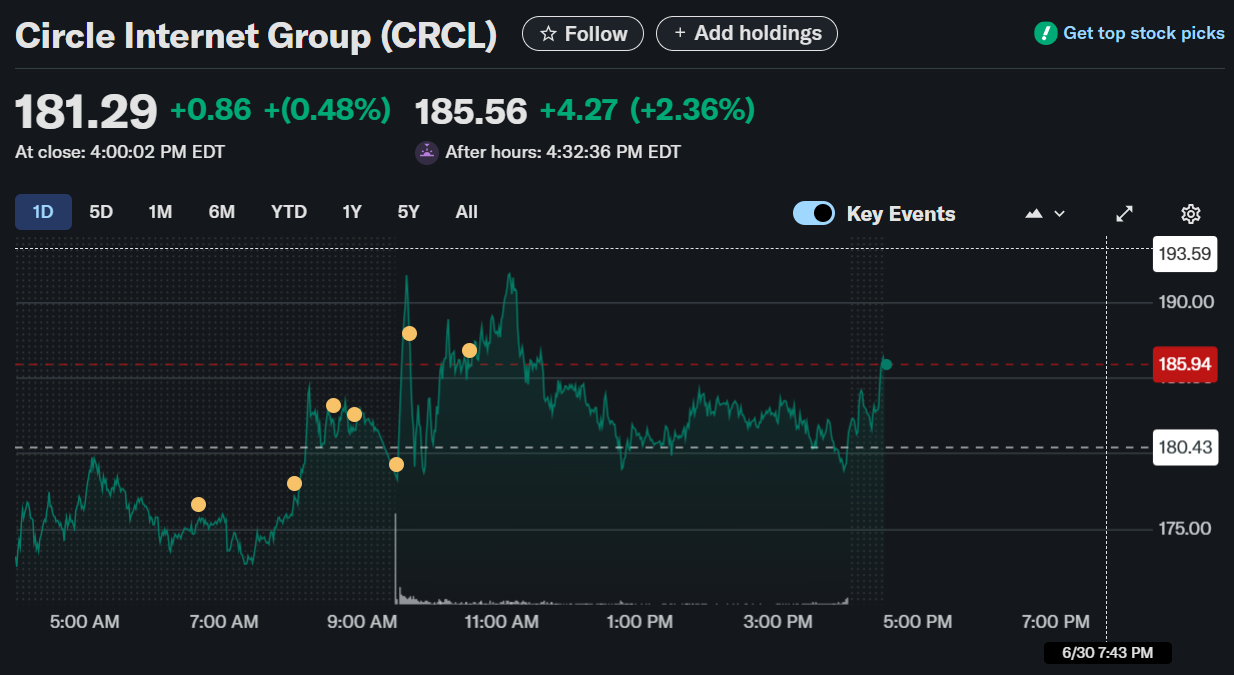TLDR
- Circle stock climbs after applying to launch a federally regulated trust bank to oversee USDC
- Circle takes major step toward becoming a national digital currency bank with OCC application
- New trust bank would let Circle manage USDC reserves and offer secure custody for digital assets
- Circle strengthens global compliance by aligning with US, EU, and UAE financial regulations
- Upcoming stablecoin law could boost adoption and Circle is preparing with strategic trust bank move
Circle Internet Group (NYSE: CRCL) closed at $181.29 with a gain of 0.48% during regular trading. After the market closed, shares surged 2.55% to $185.92. The stock moved higher following the company’s announcement of its application to establish a national trust bank.
Circle submitted its application to the Office of the Comptroller of the Currency (OCC) for the creation of First National Digital Currency Bank, N.A. The proposed entity would operate as a federally regulated trust bank and manage USDC reserves. It would also provide digital asset custody services to institutional clients under strict federal oversight.
🚨BREAKING: Circle has applied for a national trust bank licence in the US.
If granted, Circle's license could integrate USDC into mainstream U.S. banking, boosting crypto adoption. 💪 pic.twitter.com/8PIFs0a9nY
— Marzell (@MarzellCrypto) June 30, 2025
This move follows Circle’s IPO earlier this month, which valued the company at nearly $18 billion. The firm is positioning itself for compliance with the expected GENIUS Act legislation. It plans to strengthen its stablecoin infrastructure and expand into mainstream financial services.
Trust Bank Would Oversee USDC Reserve Management
The charter would authorize Circle’s new trust bank to manage the USDC reserve directly. The reserves currently include short-term U.S. Treasury bills and repurchase agreements. These assets are held by custodians such as BNY Mellon and managed by BlackRock.
If approved, the new entity would reduce dependence on third-party custodians. However, Circle confirmed that some assets would remain with traditional banks. This approach aims to maintain redundancy while expanding in-house oversight capacity.
The charter does not permit Circle to take deposits or offer loans, unlike traditional banks. Instead, the trust will focus on safekeeping assets, particularly tokenized securities. This aligns with the company’s broader plan to support institutional use of blockchain-based financial infrastructure.
Circle Aligns Operations With Global Regulatory Standards
Circle continues to pursue a regulatory-first approach across major markets. In 2015, the company secured the first BitLicense from the New York Department of Financial Services. In 2024, it became the first stablecoin issuer to comply with the European Union’s MiCA regulation.
In 2025, Circle also received in-principle approval to operate as a money services provider in Abu Dhabi. These steps build a foundation for the firm’s long-term compliance goals. The OCC application represents another milestone in its strategic roadmap.
The firm issues USDC, a dollar-pegged stablecoin used in global digital transactions. USDC is fully backed by liquid reserves to maintain its 1:1 peg with the U.S. dollar. Circle aims to increase confidence by operating under a national regulatory charter.
Market Moves Toward Broader Stablecoin Integration
The U.S. Congress recently passed a bill to create a federal framework for stablecoins. The House is expected to approve it in the coming weeks. President Trump is anticipated to sign it into law shortly after.
The bill will require stablecoins to be backed by liquid assets and mandate public disclosure of reserve composition. This development could accelerate adoption by traditional financial institutions. Circle’s planned trust bank positions it well for this shift.
Anchorage Digital currently holds the only national trust bank charter among digital asset companies. Circle’s application signals its intention to join that limited group. The company aims to support future demand for secure, compliant digital finance infrastructure.
With rising legislative clarity and increasing institutional interest, Circle’s strategy reflects confidence in the sector’s evolution. The after-hours stock movement suggests the market acknowledged the significance of this regulatory step.







